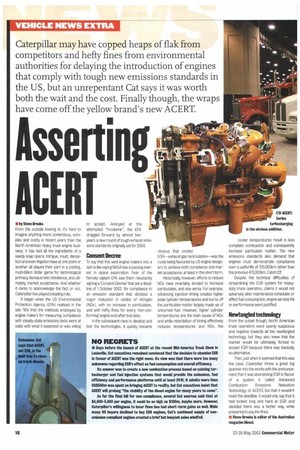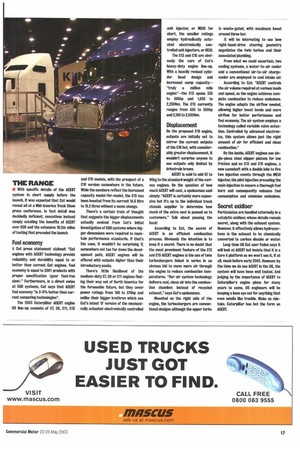Asserting ACERI
Page 16

Page 17

If you've noticed an error in this article please click here to report it so we can fix it.
• by Steve Brooks From the outside looking in, its hard to imagine anything more contentious, complex and costly in recent years than the North American heavy truck engine business. It has had all the ingredients of a seedy soap opera. Intrigue, insult, deception and even litigation have at one point or another all played their part in a jostling, multi-billion dollar game for technological primacy, bureaucratic obedience, and ultimately, market acceptance. And whether it cares to acknowledge the fact or not, Caterpillar has played a leading role.
it began when the US Environmental Protection Agency (EPA) realised in the late '90s that the methods employed by engine makers for measuring compliance with steady-state emissions tests were at odds with what it expected or was willing to accept. Annoyed at this attempted "hoodwink", the EPA dragged forward by almost two years a new round of tough exhaust emissions standards originally set for 2004.
Consent Decree
To say that this sent engine makers into a spin s like saying NASA has a passing interest in space exploration. Fear of the fiercely vigilant EPA saw them reluctantly signing a 'Consent Decree' that set a deadline of 1 October 2002, for compliance to an emission standard that dictated a major reduction in oxides of nitrogen (N0x), with no Increase in particulates, and with hefty fines for every 'non-conforming' engine sold after that date.
In the subsequent race to develop and test the technologies, it quickly became obvious that cooled EGR—exhaust gas recirculation—was the route being favoured by US engine designers to achieve both compliance and market acceptance, at least in the short term.
Historically however, efforts to reduce NCix have invariably tended to increase particulates, and vice versa. For example, advancing injection timing creates higher peak cylinder temperatures and burns off the particulate matter largely made up of unburned fuel. However, higher cylinder temperatures are the main cause of NOx and while retardation of timing effectively reduces temperatures and NOx, the cooler temperatures result in less complete combustion and subsequently increase particulate matter. The new emissions standards also demand that engines must demonstrate compliance over a useful life of 700,000km rather than the previous 470,000km. Catch 22!
Despite the technical difficulties of streamlining the FOR system for heavyduty truck operation, claims it would not adversely alter maintenance schedules or affect fuel consumption, engine service life or performance seem justified.
Newfangled tecfmology
From the outset though, North American truck operators were openly suspicious and negative towards all this newfangled technology, but they also knew that the market would be ultimately forced to accept EGR because there was basically no alternative.
Then, just when it seemed that this was the case, Caterpillar threw a great big spanner into the works with the announcement that it was abandoning EGR in favour of a system it called Advanced Combustion Emissions Reduction Technology, or ACERT, but that it wouldn't meet the deadline. It would only say that it had looked long and hard at EGR and decided there was a better way, while preparing to pay the fines.
• Steve Brooks is editor of the Australian magazine Diesel.
THE RANGE
With specific details of the ACERT system in short supply before the launch, it was expected that Cat would reveal all at a Mid-America Truck Show press conference. In fact detail was decidedly deficient, executives instead simply extolling the benefits of ACERT over EGR and the extensive 10.2m miles of testing that preceded the launch.
Fuel economy
A Cat press statement claimed: "Cat engines with ACERT technology provide reliability and durability equal to or better than current Cat engines. Fuel economy is equal to 2001 products with proper specification (gear fast/run slow)." Furthermore, in a direct swipe at EGR systems, Cat says that ACERT fuel economy in 3-5% better than current competing technologies".
The 2003 Caterpillar ACERT engine US line-up consists of C7, C9, C11, C13 and 015 models, with the prospect of a 018 version somewhere in the future. While the numbers reflect the increased capacity model-for-model, the 015 has been boosted from its current 14.5 litre to 15.2 litres without a name change.
There's a certain train of thought that suggests the bigger displacements actually evolved from Cat's initial investigation of EGR systems where bigger dimensions were required to maintain performance standards. If that's the case, it wouldn't be surprising if, somewhere not too far down the development path, ACERT engines will be offered with outputs higher than their introductory peaks.
There's little likelihood of the medium-duty 07, CS or C11 engines finding their way out of North America for the forseeable future, but they cover power ratings from 190 to 370hp and unlike their bigger brethren which use Cat's latest 'B' version of the mechanically actuated electronically controlled unit injector, or MEUI for short, the smaller ratings employ hydraulically actuated electronically controlled unit injectors, or HER The 013 and C15 are obviously the core of Cat's heavy-duty engine line-up. With a heavily revised cylinder head design and increased sump capacity— 'truly a million mile engine"—the C13 spans 335 to 505hp and 1,830 to 2,230Nm. The 015 currently ranges from 435 to 550hp and 2,100 to 2,500Hm.
Displacement
On the proposed C18 engine, outputs are initially set to mirror the current outputs of the 016 but, with considerably greater displacement, it wouldn't surprise anyone to see outputs only limited by drivetrain brawn.
ACERT is said to add 57 to 90kg to the standard weight of the various engines. On the question of how much ACERT will cost, a spokesman said simply: "ACERT is certainly more expensive but it's up to the Individual truck chassis supplier to determine how much of the extra cost is passed on to customers." Talk about passing the buck!
According to Cat, the secret of ACERT is an efficient combustion process. Obviously the intention is to keep it a secret. There is no doubt that the most prominent feature of the 013 and 015 ACERT engines is the use of twin turbochargers linked in series in an obvious bid to move more air through the engine to reduce combustion temperatures. "Our air system technology delivers coal, clean air into the combustion chamber, instead of recycled exhaust," says Cat's spokesman.
Mounted on the right side of the engine, the turbochargers are conventional designs although the upper turbo is waste-gated, with maximum boost around three bar.
It will be interesting to see how right-hand-drive steering geometry negotiates the twin turbos and their associated plumbing.
from what we could ascertain, two cooling systems, a water-to-air cooler and a conventional air-to-air chargecooler are employed to cool intake air.
According to Cat: "ACERT controls the air volume required at various loads and speed, so the engine achieves complete combustion to reduce emissions. The engine adapts the airflow needed, allowing higher boast levels and more airflow for better performance and fuel economy. The air system employs a technology called variable valve actuation. Controlled by advanced electronics, this system allows just the right amount of air for efficient and clean combustion."
On the inside, ACERT engines use single-piece steel slipper pistons for low friction and on 013 and 015 engines, a new camshaft with a double lobe to fire two injection events through the MEUI injector, the pilot injection preceding the main injection to ensure a thorough fuel burn and consequently enhance fuel consumption and minimise emissions.
Secret oxidiser
Particulates are handled externally in a catalytic oxidiser, whose details remain secret, along with the exhaust system. However, it effectively allows hydrocarbons in the exhaust to be chemically converted to carbon dioxide or water.
Long-time UK Cat user Foden says it will look at ACERT but insists that it is a Euro 4 platform so we won't see It, If at all, much before early 2005. However, by the time we do see ACERT in the UK, the system will have been well tested. And judging by the importance of ACERT to Caterpillar's engine plans for many years to come, US engineers will be keeping a keen eye out for anything that even smells like trouble. Make no mistake, Caterpillar has bet the farm on ACERT.
































































































































































